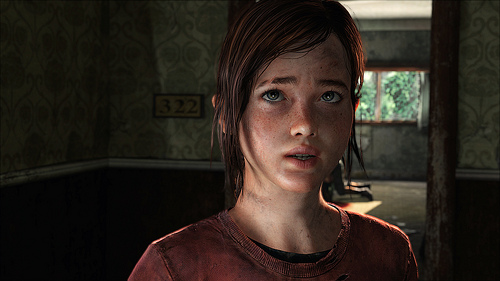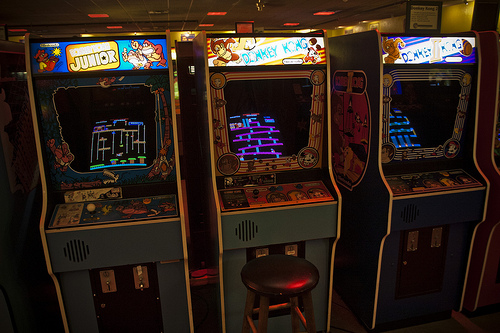
Photo by naughty_dog / CC 2.0
If you’re a gamer, you’re probably just as cynical as I am when you hear about the next video game based movie on the horizon. It almost seems a rule of thumb that films adapted from video games are guaranteed to disappoint. Even successful franchises like the Resident Evil series, which is now working on its sixth installment, aren’t exactly considered film gold. Yet, this doesn’t seem to slow Hollywood down as over thirty new titles are rumored to be currently in the works. So what is it about video games and film that seem so incompatible?
Structure of Video Games vs. Film, Literature and Theater

Photo by Rob Boudon / CC 2.0
One thing that film has in common with literature and theater is that the story structure is relatively the same. All three often follow a Freytag’s Pyramid structure. Certainly this is not the always case, all three mediums play with this structure and break rules from time to time, but for the most part, this structure of storytelling is present in the vast majority of books, plays and films we consume day to day. This makes adapting a novel or play to the silver screen easier, as you pretty much already have a blueprint to get from point A to B. The rest is simply editing out what you don’t want or adding your own artistic voice to original material.
Video games, on the other hand, particularly older ones, don’t follow this style of storytelling. In early games like Pacman, very little was explained in terms of backstory. Officially, all that’s really known about Pacman is he’s really hungry guy with no appendages, being chased by angry undead. It’s essentially what would happen if you dropped Mr. Creosote from Monty Python’s The Meaning of Life into the zombie apocalypse. There are some comical cutscenes for the player to watch, but they don’t really reveal anything new to the player in terms of story. Furthermore, Pacman has no end, so what your left with is really just a situation with characters.
Later, games like Donkey Kong would begin to establish more of a narrative. The moment you play the first level it’s apparent that a giant ape with unlimited barrels and fireballs for friends has kidnapped your girlfriend. Unlike Pacman, Donkey Kong has an ending where our hero tears down the very structure of the level, causing the great ape to crack his head open. He is reunited with his girlfriend and the two look lovingly at one another while Donkey Kong exhibits the first signs of severe, irreversible brain damage.
Today’s games posses far more plot and story structure than their predecessors. Games like Farcry and The Last of Us, deal with complicated issues like revenge and the human condition. Many of their cutscenes take a page from cinema, allowing characters to express their feelings and motivations even though the player is actively controlling them.
Control Issues
Despite the amount of progress video games have made in the storytelling department, for the most part video games are still fundamentally goal based, requiring the player to perform a set of menial tasks to drive the story forward. Even games like Gone Home, which toe the line between film and gaming, require the player to actively search for clues to tell the narrative. This affects the structure of the story in that the player decides how they want to progress. Gamers familiar with the Grand Theft Auto series are familiar with this, as it’s not uncommon to devote 20+ hours to side missions before moving on to the main storyline. Simply put, if story structure in film, literature and theater is meant to be a rollercoaster ride, video games put you in the seat of a formula one car.

Zoom, Zoom…
Photo by Julien Reboulet / CC 2.0
This poses a problem when trying to adapt a game to the screen. Since the transfer from video game to film requires the viewer lose control of the character, how can you stay faithful to original source material that relies on player/character interaction to tell the story?
The Loss in Translation
People look forward to film adaptations of literature and theater because we tend to gain something from the transfer. Theater requires a certain level of distance between the viewer and the actors. Camera tricks such as close ups and point of view shots bring audience members closer, giving them an almost god-like view of the action. In literature, we give up the use of imagination, but film puts the senses of sight and sound into play that can’t fully be expressed through the written word.
Video games, particularly modern ones, interact with most of our senses, but other than maybe getting to see our favorite movie stars portray the roles, we really lose a lot when we give up the control to the actor. The desire for control is probably best illustrated by the much hated “Noisy audience member”. You know, the person who insists on directing the clueless camp counselor not to enter that cabin because we all know Jason is lurking in the shadows with a machete. Although irritating, it perfectly illustrates people’s desire for control.
Don’t get me wrong; I’m not saying that it’s impossible to make a good movie based off a video game. Still, I do believe filmmakers should attempt to make the story their own and not try and recreate certain moments from games that don’t translate well. Putting a POV shot in the Doom movie isn’t going to trick anyone into thinking they’re reliving the game any more than putting pictures in a Harry Potter novel will make someone think they’re reading in IMAX. Choices like this only serve as mindless fan service. I can only hope that cinematically inspired games like Uncharted can provide suitable enough story content to rely on, where games like Super Mario Brothers couldn’t.
Distilling a game that basically plays like a movie would be easier. I’d sooner watch a David Cage inspired movie than play one of his games.
LikeLiked by 1 person
I’m sure David Bowie is still available for an Omikron movie.
LikeLike
Essays like this are so important to braoedning people’s horizons.
LikeLike